Groundbreaking Study Reveals Comb Jellies Can Fuse Bodies, Shedding Light on Tissue Integration and Immune Systems
October 7, 2024
A groundbreaking study led by Kei Jokura from the University of Exeter and the National Institutes of Natural Sciences, published in Current Biology on October 7, 2024, reveals that certain comb jellies, specifically Mnemiopsis leidyi, can fuse their bodies to form a single organism.
This remarkable discovery occurred during routine research at the Marine Biological Laboratory in Woods Hole, Massachusetts, when researchers identified a larger-than-normal sea walnut, prompting further investigation into the phenomenon of fusion.
Initial observations of the fused jellies revealed they had two backends and two apical organs, leading researchers to hypothesize that they were the result of fusion.
To explore this fusion process, Dr. Oscar Arenas and his team replicated the conditions by injuring pairs of sea walnuts and pinning them together overnight, successfully inducing fusion in nine out of twenty pairs.
The fused individuals exhibited rapid neural integration, responding collectively to stimuli within two hours, indicating a synchronization of their nervous systems.
Notably, when one jelly was fed fluorescent food, the particles appeared in the digestive system of the other jelly, suggesting a lack of tissue recognition and the ability to share resources.
Understanding this fusion process may have significant implications for regenerative medicine, as it sheds light on immune system mechanisms and the potential for tissue grafting.
The absence of allorecognition in these sea walnuts, which is the ability to distinguish between self and nonself tissue, raises intriguing questions about their evolutionary biology and necessitates further research into their neurology and genetics.
Future studies will investigate whether other species of comb jellies, such as Bolinopsis mikado, possess similar fusion capabilities, expanding our understanding of this phenomenon.
This fusion behavior, while fascinating, is believed to be extremely rare in the wild due to the specific conditions required, such as close proximity between injured individuals.
The findings not only highlight the unique biological traits of comb jellies, including their ability to integrate tissue without adverse effects, but also position them as valuable models for studying evolutionary processes.
Ultimately, this research could inform improvements in human transplant techniques, potentially reducing organ rejection by understanding how these ancient creatures manage tissue integration.
Summary based on 11 sources
Get a daily email with more Science stories
Sources

The New York Times • Oct 7, 2024
When Two Sea Aliens Become One
The Guardian • Oct 7, 2024
Comb jellies fuse together when injured, study finds
Popular Science • Oct 8, 2024
Two comb jellies can fuse together into one–and keep both butts
Phys.org • Oct 7, 2024
After injury, one species of comb jelly can fuse to become one